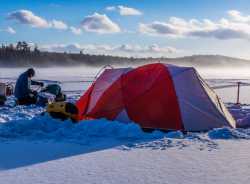>>2801771It's really dependent on just how cold it is how different the equipment is. But the big feature is that you have manage heat and moisture differently. In the summer it doesn't matter if your hands are wet but in sub-freezing that's a major concern.
Layering is basically the same, you just need more insulation. Something different for winter is that you'll want to look not just at your body but your insulation against the ground and objects. A sitting pad to keep your ass, knees, or even feet from cold ground. Thin inner gloves so that you can manipulate things without exposed skin. A closed cell sleeping pad on top of your normal air pad. A warm sleeping bag, rated not just for the expected temps but better. A clear sky on a windy night can drop temps quickly.
Shelter is very often the same, you can still hammock, tent, tarp, like you do in 3 season weather. You just need to pay far more attention to site selection. Learn about how local geography can affect temps. Create barriers with snow or gear to slow air flow under the tarp. Mitigate condensation when possible.
Food you can just eat a little more of it. Find a way to insulate what you are eating out of to keep it warm longer. Consume warm beverages to raise your body temp. Use hot water in a nalgene to pre-heat your sleeping bag. Take a look at your cooking solution and under stand how it is affected by cold temps.
Far from exhaustive here. Lots of good resources out there if you look. Aaron Linsdau is dry but he is well versed in extreme cold weather and I have gotten a lot of info and inspiration from him. And test your gear! Car camping, in the yard, somewhere with a very short hike in, etc. all useful to test your setup in the cold while keeping a bail out. And if you can, bring a thermometer and track temps, nothing informs future decisions like actual data.

